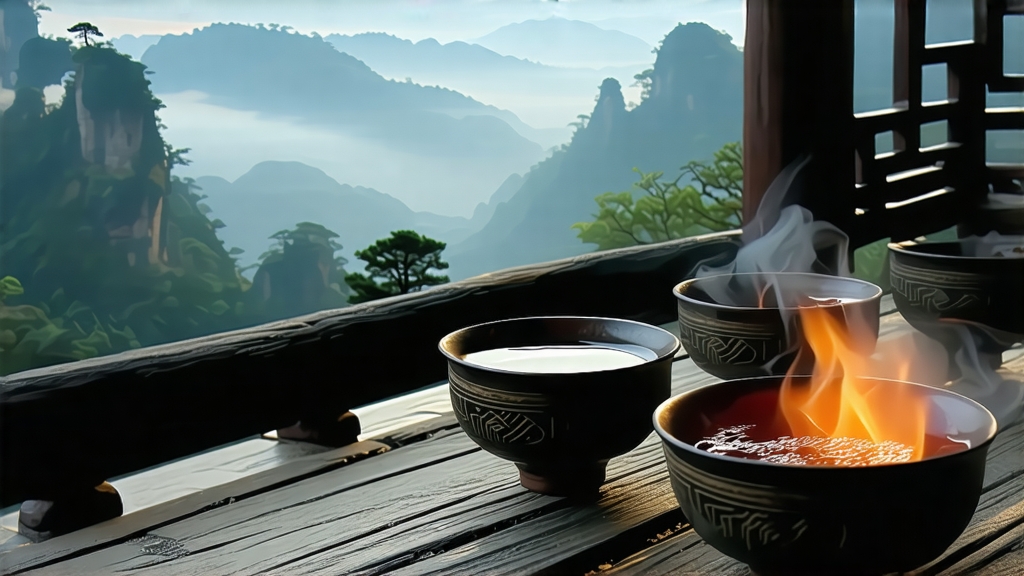
Long before English breakfast blends and afternoon tea services filled drawing rooms from London to Calcutta, one small-leaf black tea from the granite gorges of northern Fujian had already sailed across the Indian Ocean and altered the global palate forever. That tea is Lapsang Souchong—today celebrated as the world’s earliest fully oxidized black tea and still the only one whose finishing note is the incense of fresh pine. To understand its story is to trace the very arc of international tea commerce, from Ming-dynasty border trade to twenty-first-century sommelier competitions.
History: From Mountain Refuge to Global Commodity
Local legend places the birth of Lapsang Souchong in the Tongmu Guan (Tongmu Pass) sector of the Wuyi Mountains around 1568, late in the Ming dynasty. Banditry had disrupted the spring tea harvest, forcing villagers to delay leaf processing. When the green leaves had already begun to redden, a resourceful farmer dried them over a fire of fresh Masson pine to halt further spoilage. The resulting tea—sweet, resinous, and unexpectedly bright—found favor with passing merchants on the Tea Horse Road. By 1604 Dutch traders had carried it to Java and then to Europe, where it became the prototype for the word “bohea,” a corruption of “Wuyi.” When Catherine of Braganza brought her tea habit to the English court in 1662, the pine-smoked leaf was the exotic black tea that set London’s fashion.
Terroir and Leaf Grade Hierarchy
Tongmu Guan is a narrow, fog-locked canyon at 27° N latitude where day-night temperature swings exceed 15 °C and humidity hovers above 80 %. The soil is weathered granite rich in potassium and manganese, feeding indigenous cultivars such as Xiao Ye Zhong (Small-Leaf Species) and the even rarer Ye Sheng (Wild) tea trees that cling to cliff crevices. Within Lapsang Souchong there exists a subtle caste system:
- Wild High-Peak Souchong: plucked at 1,200–1,400 m from uncultivated trees; buds golden, downy, and limited to barely 300 kg per spring.
- Traditional Tongmu Souchong: leaves picked from 300- to 500-year-old bushes rooted in the canyon floor; oxidation slower, smoke softer.
- Waishan Souchong: leaf from neighboring counties brought into Tongmu for smoking; larger, darker, more affordable yet still legally protected under the geographical indication “Zheng Shan Xiao Zhong.”
Craft: Smoke as Timekeeper
Unlike any other black tea, Lapsang Souchong is defined by its smoke-drying stage, yet the best grades receive only a whisper of resin, not the tarry blast often associated with export versions. The craft unfolds in four controlled acts:
Withering: Fresh leaves are laid on bamboo screens inside a qinglou (three-story wooden house) whose ground floor holds a shallow pit of smoldering pine embers. Ambient heat and convection, not direct flame, desiccate the leaf to 60 % moisture within 8–10 hours.
Rolling: Once limp, the leaf is hand-kneaded for 45 minutes, breaking cell walls and initiating enzymatic oxidation. The juice exudes a fragrance of honey and mountain orchid before smoke ever touches it.
Oxidation: Rolled leaf rests in cedar-lined crates for 3–4 hours at 24 °C. Color shifts from jade to copper; flavonols convert into theaflavins that will later balance the resinous top notes.
Smoke-Drying: The critical signature. A small pine-log fire is banked until flames die and only fragrant blue coils rise. The tea master spreads the oxidized leaf on sieves 1.5 m above the embers, turning it every 20 minutes for two hours. Premium lots may repeat this cycle on the third day, using only the heartwood of 40-year-old Chinese red pine, whose resin has mellowed. The goal is not to mask the leaf but to marry sweet malt with cool camphor and a distant campfire memory.
Chemical Alchemy in the Cup
Gas chromatography reveals that the smoking phase deposits guaiacol, 4-methylguaiacol, and syringol—